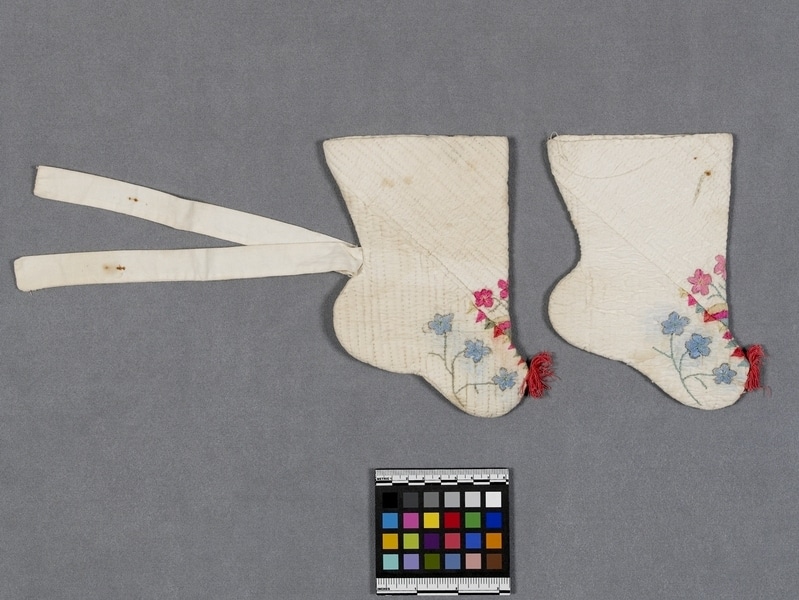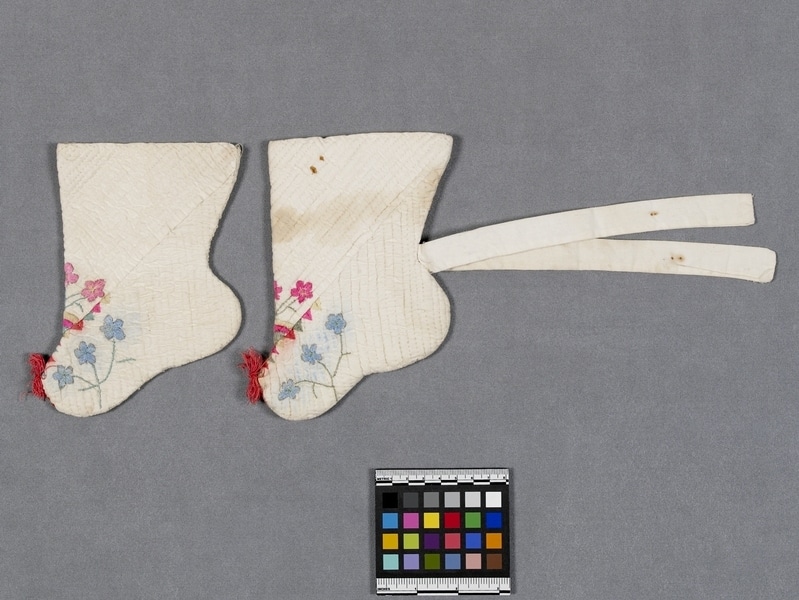Quilted Socks Item Number: 1553/10 a-b from the MOA: University of British Columbia


Description
Pair of baby’s socks (part a-b) made of white fabric, finely quilted in narrow parallel rows. The rows on the foot are vertical; those on the front of the ankle are diagonal. Socks are flat, with a seam around outer edge. The two layers are joined with an invisible stitching seam at the top. They are embroidered with floral motifs in blue-green and dark pink and four lozenges in dark pink and green. There is a dark pink tassel on the toe and a long white tie attached at the back of the ankle.
History Of Use
Such socks were worn by baby girls on special occasions, such as the child’s first birthday or a festival. Fine quilting with narrow lines like this would have been done at home. The triangles, “jat-mul-rim” above the tassels were originally pieces of satin, but later were rendered with embroidery.
Specific Techniques
All seams are concealed; they are stitched inside out and then turned. The socks were assembled and embroidered flat, and then finished by stitching along the sole and back of ankle.
Iconographic Meaning
The pink or red colour of the tassel shows that the socks were for a girl. The parallel lines of quilting represent wishes for a long life. The flowers are peach flowers, representing long life and having the power to expel devils.
Item History
- Made in Korea between 1890 and 1910
- Collected between 1905 and 1918
- Owned by Marjorie H. Clark before October 26, 1992
- Received from Marjorie H. Clark (Donor) on October 26, 1992
What
- Name
- Quilted Socks
- Identification Number
- 1553/10 a-b
- Type of Item
- sock
- Material
- cotton fibre, silk fibre and dye
- Manufacturing Technique
- spun, woven, cut, sewn, turned, quilted and embroidered
- Part A
- height 17.0 cm, width 11.0 cm
- Part B
- height 17.5 cm, width 11.5 cm
Who
- Culture
- Korean
- Previous Owner
- Marjorie H. Clark
- Received from
- Marjorie H. Clark (Donor)
Where
- Holding Institution
- MOA: University of British Columbia
- Made in
- Korea
When
- Creation Date
- between 1890 and 1910
- Collection Date
- between 1905 and 1918
- Ownership Date
- before October 26, 1992
- Acquisition Date
- on October 26, 1992
Other
- Item Classes
- textiles
- Condition
- fair
- Accession Number
- 1553/0010 a-b